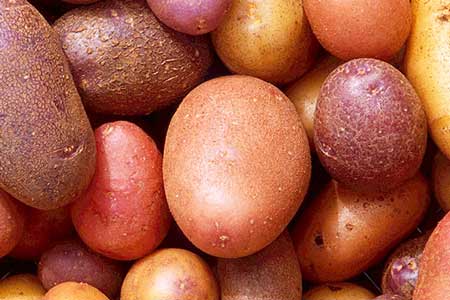Potatoes
How to grow
There is nothing quite like the taste of new potatoes straight from the garden. Add to this the satisfaction and sense of achievement, the knowledge that your potatoes are free of pesticides, and the savings in money...now you have some very powerful reasons for growing your own!
At a Glance
- Prefer a warm, sunny site
- Like Free draining soil with compost added
- Always use quality seed potatoes
Selecting the site
Potatoes will grow best in a warm sunny position. They will not grow and yield in the shade or where they have to compete for light and moisture. Shelter from strong winds is also of benefit. The size of the potato garden depends on the size of your family and your requirements.
Soil
Potatoes require a free-draining soil, rich in organic matter (compost). In clay soils, the potato plot should be raised or built up some 15cm above the surrounding soil to ensure good drainage.
The ‘Seed’ Potatoes
Potatoes are grown from tubers known as ‘seed potatoes’. These ‘seed potatoes’ are grown especially for this purpose, in areas that are free of virus diseases. Potato virus diseases can severely reduce yield if the seed potato is infected, so avoid cheap seed potatoes which may not be virus free.
With potatoes being a major vegetable in our diet, not surprisingly there are numerous varieties with distinct differences in shape, colour, size, yield, time to maturity, taste, and suitability for mashing, boiling, baking or chipping.
Sprouting
It is a good idea to ensure ‘seed potatoes’ have a good strong growing shoot emerging from the tuber prior to planting.
Buy your ‘seed potatoes’ a few weeks in advance of planting time, and place them in a tray positioned in a warm, dry and airy position. This will encourage sprouting.
Potato Varieties
When choosing varieties it is a good idea to select varieties according to your needs and to give a spread of maturity with the late ones being stored for the winter.
Early varieties tolerate the cool early season and are quickest to maturity. They tend to be lower yielding and not good keepers but they are great for that early taste of new potatoes. They can be planted in early September in our districts, but will need protection from late frosts.
POPULAR EARLY VARIETIES:
- Rocket
- Swift
- Cliffs Kidney
- Jersey Bennes
- Ilam Hardy
Main crop varieties cover most, which have an intermediate growing period, maturing in 100—120 days. These varieties are best planted in September and October.

GOOD MAIN CROP VARIETIES:
- Red Rascal
- Desiree
- Red King (red skinned varieties) which are good all-purpose varieties.
- Agria a pale golden flesh with great taste and good for mashing.
- Karaka is a new variety bred in NZ and regarded as The Great All Rounder.
Late varieties tend to be the slower to maturity, high yielding, good for storage varieties.
GOOD LATE CROP VARIETIES:
- Heather — a purple skinned variety (the purple disappears with cooking) which has firm large tubers and a high yield. A general purpose variety which keeps well.
- Rua — an older type which produces high yields of large oval flat tubers. A good keeper.
Feeding
Prior to planting, apply a dressing of lime. Work this into the soil and leave for a week, then add Tui General Fertiliser or Potato Food (do not use with pots) and work this into the soil as well.
Planting
Potatoes are tubers which form off the underground stem of the plant (they are stem tubers not root tubers).
Hence to produce a good crop it is necessary to ensure there is a significant amount of stem covered with soil.
The ‘seed potatoes’ are planted in a hole or trench about 100mm deep, about 40—50cm apart in rows about 80 cm apart.
Mounding Up Planting
When the potatoes have emerged to 20cm high mound up the soil almost covering the emerged tops.
When they have grown another 20—30cm, repeat the process.
This produces a large mounded row in which the new potato tubers will grow.
Watering
Potatoes tolerate reasonably dry conditions, but in very dry weather they may require regular watering.
Pests & Diseases
The major disease of potatoes is late blight. Despite its name, it often occurs early in the season or late, attacking in wet cool conditions. Once infested it will spread rapidly. Initially black blotches appear on the leaves, which spread to total defoliation.
Control by thoroughly spraying at the very first sign of black spots with Kiwicare Organic Super Suplhur.
POTATO PSYLLID—A NEW PEST
A major newly-arrived pest of potatoes is the Potato psyllid. The limpet like insect attaches itself to the undersides of leaves. As it sucks the sap it also injects a toxin into the plant which inhibits the formation and sizing of the new potato tubers. Once this pest is present in your area, regular preventative spraying with Yates Mavrik is required.

6834